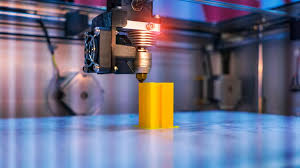3D printing, once considered a niche technology, has rapidly evolved into a transformative force across industries. From prototyping to manufacturing and even healthcare, 3D printers are revolutionizing the way we create and produce objects. But what exactly is 3D printing, and why has it become such a pivotal technology in today’s world? Let’s dive into the world of 3D printers, their applications, and the profound impact they are making in various sectors.
What is a 3D Printer?
At its core, a 3D printer is a machine that creates three-dimensional objects from a digital file. Unlike traditional manufacturing methods, which often involve cutting or molding materials, 3D printing builds objects layer by layer. This process, known as additive manufacturing, enables the creation of complex shapes and structures that would be difficult or impossible to achieve with traditional techniques.
The digital design, often created using computer-aided design (CAD) software, is sliced into thin layers by the printer’s software. The 3D printer then follows these instructions, laying down material layer by layer until the object is complete. Common materials used in 3D printing include plastics, metals, ceramics, and even biological substances for medical applications.
Types of 3D Printers
There are several types of 3D printers available, each suited to different applications:
- Fused Deposition Modeling (FDM): One of the most common and affordable types of 3D printing, FDM printers extrude thermoplastic filaments to create objects. This type is often used for prototyping and hobbyist projects.
- Stereolithography (SLA): SLA printers use a laser to cure liquid resin into hardened plastic. They produce highly detailed prints and are often used in industries like jewelry design and dentistry.
- Selective Laser Sintering (SLS): SLS printers use a laser to fuse powdered materials, typically metals or plastics, into solid objects. These printers are often used in industrial applications due to their ability to print with high precision and durability.
- Digital Light Processing (DLP): Similar to SLA, DLP uses a digital projector to cure resin, producing objects layer by layer. This type is known for its speed and high level of detail.
- Metal 3D Printing: Metal printers, including technologies like Direct Metal Laser Sintering (DMLS), use powdered metals to create parts and objects. These printers are widely used in industries such as aerospace, automotive, and healthcare, where strong, durable parts are essential.
Applications of 3D Printing
The versatility of 3D printing has led to its widespread adoption across numerous sectors. Let’s explore some of the key areas where 3D printing is making a significant impact:
- Prototyping and Product Development: Traditionally, creating prototypes could be time-consuming and expensive. 3D printers have revolutionized this process by allowing companies to quickly produce prototypes at a fraction of the cost. Engineers and designers can now iterate on their designs faster, accelerating product development cycles.
- Healthcare: One of the most groundbreaking applications of 3D printing is in the medical field. Custom prosthetics, dental implants, and even bio-printed organs are now possible thanks to this technology. Surgeons can create patient-specific models of organs and bones to practice complex procedures, improving surgical outcomes.
- Manufacturing: 3D printing is increasingly being used in manufacturing, especially for producing small batches of custom or complex parts. It has also opened doors for decentralized production, where parts can be printed on demand, reducing inventory and transportation costs.
- Education: 3D printers are becoming a staple in educational institutions, allowing students to bring their ideas to life. From engineering and architecture to art and design, students across disciplines are using 3D printers to enhance their learning experiences.
- Architecture and Construction: Large-scale 3D printers are even capable of constructing buildings. This technology allows for faster, more efficient construction, and it has the potential to address housing shortages by enabling the creation of affordable, customizable homes.
- Fashion and Art: Designers and artists are using 3D printing to push the boundaries of creativity. Complex, custom garments, footwear, and art pieces can now be produced with ease, allowing for greater personalization and innovation in design.
Advantages of 3D Printing
The rise of 3D printing comes with a range of benefits that have transformed industries:
- Cost Efficiency: 3D printing reduces material waste and allows for on-demand production, lowering costs for prototyping and small-batch manufacturing.
- Customization: One of the standout advantages of 3D printing is the ability to produce highly customized products, from medical implants to personalized consumer goods.
- Speed: Prototypes and products can be produced much faster than with traditional manufacturing methods, enabling rapid iteration and faster time-to-market for new products.
- Sustainability: 3D printing has the potential to reduce environmental impact by minimizing waste, utilizing fewer resources, and cutting down on transportation emissions through localized production.
Challenges Facing 3D Printing
While 3D printing offers numerous advantages, it is not without its challenges. Material limitations, the high cost of industrial-grade printers, and concerns about intellectual property are some of the hurdles that need to be addressed for broader adoption. Additionally, scaling up 3D printing for mass production remains a challenge, though advancements are being made in this area.
The Future of 3D Printing
As the technology continues to advance, the future of 3D printing looks promising. New materials and methods are constantly being developed, expanding the possibilities for what can be printed. With ongoing innovation, 3D printing will likely become an integral part of industries ranging from healthcare to aerospace, shaping the way we design, create, and produce goods for years to come.
In conclusion, 3D printers have moved beyond the realm of novelty and are now driving innovation across a wide range of industries. Their ability to produce complex, customized objects quickly and affordably has revolutionized manufacturing, healthcare, education, and more, making 3D printing one of the most exciting technological advancements of our time.
